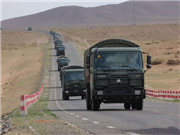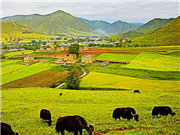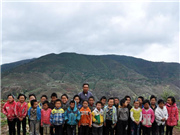

V. Rights of Ethnic Minorities
In 2014 China's ethnic minorities and areas inhabited by ethnic minorities made new developments in various social programs, and ethnic minorities' civil, political, economic, cultural and social rights were further guaranteed.
The rights of ethnic minorities to participate in the administration of the state are effectively guaranteed. All ethnic autonomous areas enjoy autonomous rights in a wide range of areas in accordance with the law, including local legislative power, flexibility in the execution of relevant state laws and regulations based on the characteristics of each ethnic minority, the right to use their own spoken and written languages, power of personnel and financial management, and the right of independently developing their own culture and education. Nationwide, the number of civil servants from ethnic minorities keeps increasing. The proportion of such civil servants in the total number of civil servants is higher than the proportion of ethnic minorities in the country' s total population, and is on the rise every year. In Tibet, of the 34,244 deputies to the people' s congresses at all four levels, 31,901 persons, or 93 percent, are from the Tibetan or other minority communities. The Tibet Autonomous Region has 20 deputies to the NPC, 14 of whom are Tibetans or from other minority groups. Tibetans and other ethnic minorities account for 70.53 percent of the government officials in the Tibet Autonomous Region. Tibetans and other ethnic minorities account for 73.03 percent of the leaders at county and township levels.
Ethnic-minority areas achieve fast economic growth. In 2014 the per capita disposable income of urban residents in the Inner Mongolia, Guangxi Zhuang, Tibet, Ningxia Hui and Xinjiang Uygur autonomous regions, and Guizhou, Yunnan and Qinghai provinces, which have large minority populations, reached 28,350 yuan, 24,669 yuan, 22,016 yuan, 23,285 yuan, 23,214 yuan, 22,548 yuan, 24,299 yuan and 22,307 yuan, respectively, a year-on-year increase of 9 percent, 8.7 percent, 7.9 percent, 8.4 percent, 10.1 percent, 9.6 percent, 8.2 percent and 9.6 percent, respectively; the per capita disposable income of rural residents in the same areas reached 9,976 yuan, 8,683 yuan, 7,359 yuan, 8,410 yuan, 8,724 yuan, 6,671 yuan, 7,456 yuan and 7,283 yuan, respectively, a year-on-year increase of 11 percent, 11.4 percent, 12.3 percent, 10.7 percent, 11.2 percent, 13.1 percent, 10.9 percent and 12.7 percent, respectively. In 2014, the total foreign trade value of these five autonomous regions and three provinces registered 814.8 billion yuan, growing by 15.4 percent over the previous year and 13.1 percentage points higher than the national growth rate. Exports reached 552.6 billion yuan, increasing by 20 percent over the previous year and 15 percentage points higher than the national growth rate. The rural impoverished population decreased by 3.57 million from the previous year, with a poverty reduction rate of 13.9 percent. The central government appropriated 4.059 billion yuan as special funds for the development of minority groups, a growth rate of 10 percent compared to 2013. Aiming to support the development of border areas, where large numbers of minority peoples reside, the central government provided 2.88 billion as assistance funds for revitalizing border areas and bringing prosperity to their residents and central budgetary investment, an increase of 88.9 million yuan over the previous year. The central budgetary investment and funds for the development of minority groups provided 1.53 billion yuan to support the development of minority groups with small populations, an increase of 87.1 million yuan compared with 2013. The state vigorously implemented protection and development projects for ethnic-minority villages with cultural significance, and provided 490 million yuan as specialized funds, up 22.5 percent over the previous year.
Quality of life in Tibet and Xinjiang keeps improving. In 2014 the growth rate of the GDP of the Tibet Autonomous Region was 3.4 percentage points higher than the national average. The region completed its housing project for farmers and herdsmen, after eight years of incremental investment that totaled 27.357 billion yuan. The region' s 2.3 million farmers and herdsmen of 460,300 households have moved into solid and convenient houses. The per capita living space of Tibetan rural and urban residents is now 33.77 sq m and 41.39 sq m, respectively. Lhasa completed a natural gas heating project, enabling 105,200 households to enjoy "warm winters." Now Tibet has a public medical and health service system combining Tibetan, Western and traditional Chinese medicine that covers all urban and rural areas of the autonomous region with Lhasa as the center. So free medical services are now available to all the farmers and herdsmen in Tibet. The subsidy for each farmer or herdsman for these medical services was raised to 380 yuan per person in 2015. The autonomous regional government allocated a special fund of 23 million yuan to set up a major disease supplementary health insurance for farmers and herdsmen. A project is being carried out to provide the "five guarantees" (food, clothing, medical care, housing and funeral expenses) to the needy and orphans in communal settings. Some 72 percent of residents entitled to the "five guarantees" are now supported, and more than 5,900 orphans have received assistance from the government in this manner. The average life expectancy in Tibet has increased to 68 years and the death rates of infants and women in childbirth have dropped significantly. The Xinjiang Uygur Autonomous Region ranks among the top in economic growth in the country, with a growth rate 2.6 percentage points higher than the national average. In 2014 the public financial revenue of the Xinjiang government reached 128.26 billion yuan, an increase of 13.7 percent compared to 2013; 70.3 percent of the public financial expenditure of the autonomous region was used to improve its people' s livelihood; the government in Xinjiang had fulfilled its promise to implement 150 key livelihood projects of 25 types. Xinjiang has ranked among the top in China in the growth of per capita disposable incomes of both rural and urban residents for three consecutive years. The region' s employed population has increased by 380,000 and its poverty-stricken population has been reduced by 100,000. Sums of 24.644 billion yuan, 26.24 billion yuan and 3.653 billion yuan have been used in building comfortable housing for 307,800 families, 265,200 government-subsidized apartments, and 30,100 units of nomad-settlement housing, respectively. The region has newly developed 134 sites of safe rural drinking water, supplying 600,000 rural residents. Some 3.42 billion yuan has been allocated for the construction and reconstruction of rural highways with a total length of 6,087 km, providing better travel conditions for 850,000 farmers and herdsmen. Xinjiang has raised the per capita funding level for the new rural cooperative medical care system to 436.9 yuan, and the per capita expenditure on public health services to 35 yuan. Screening breast cancer and cervical cancer in women, treating congenital heart disease in children, and providing medical care to those who suffer from 54 kinds, or 22 categories of serious diseases in agricultural and pastoral areas are in progress as planned.
Rapid development in education. When making educational reform and development policies, the state always gives special support to areas inhabited by ethnic minorities to develop preschool education, improve basic conditions of schools carrying out compulsory education and accelerate the development of vocational education. In 2014 the central government provided 2.4 billion yuan in the development of regular high schools at counties inhabited by ethnic minorities and with a weak educational basis. The state implements a preferential policy toward ethnic minorities and areas inhabited by ethnic minorities in college admissions, giving rural students from ethnic-minority areas easier access to high-quality higher education resources. The state adopts special measures of "preparatory classes for ethnic minorities" and "plan for high-caliber personnel of ethnic minorities" for personnel training of ethnic minorities. In 2014 there were 53,000 ethnic-minority students enrolled in preparatory classes, up 3.31 percent over the previous year.
Cultural services keep growing. Ethnic-minority areas have improved their cultural public service system. A total of 104 radio stations and television stations in ethnic autonomous areas at provincial and municipal levels run 191radio programs, including 45 programs broadcast in ethnic-minority languages, and 215 TV programs, including 42 programs broadcast in ethnic-minority languages. There are more than 50,000 cultural institutions of various types in ethnic autonomous areas. The "Cultural Volunteers Going to Border Areas" activity has attracted about 10,000 volunteers, giving and running more than 1,200 performances, lectures and exhibitions in border areas inhabited by ethnic minorities. Training courses have been held on 7,000 occasions, and several million people have benefited. The projects "Digital Cultural Corridor in Border Areas" and "Tibetan, Qiang &Yi Cultural Corridor" have been carried out in border areas inhabited by ethnic minorities, aiming to build a digital cultural service network with broad coverage and high effectiveness.
Respecting and safeguarding the right of ethnic minorities to use and develop their own spoken and written languages. The state takes concrete measures to ensure the legitimate use of ethnic-minority languages in the administrative and judicial sectors, news and publication, radio, film and television, culture and education, and other areas. China National Radio and local radio stations broadcast in 21 ethnic-minority languages on a daily basis. There are ten Tibetan-language magazines and 22 Tibetan-language newspapers in Tibet. Tibet People's Radio has 42 programs in Tibetan. Tibet TV Station has a Tibetan-language channel broadcasting 24 hours a day. Bilingual teaching is done in the classroom in more than 12,000 schools around the country. There are more than four million students receiving bilingual education, and over 200,000 bilingual teachers. Tibet has more than 400,000 students receiving bilingual education at the stage of compulsory education, accounting for 97 percent of the total.
Cultural relics and historic sites effectively preserved. China has further enhanced the preservation of intangible cultural heritage projects and their representative inheritors in ethnic-minority areas. Tibet has nearly 800 intangible cultural heritage projects. Tibetan opera and the Gesar Epic have been included in UNESCO' s Masterpieces of the Intangible Heritage of Humanity, and 158 books have been put on the State List of Valuable Ancient Books. In 2014 the preservation and maintenance of the three key projects of the Potala Palace, Norbulingka and Sakya Monastery was completed, for which more than 380 million yuan was used. This is the largest project for the preservation and maintenance of cultural relics in Tibet, with the most funds from the central government, in which sci-tech means have been widely applied and the latest construction techniques have been used. "Silk Road: the Route Network of the Chang' an-Tianshan Corridor" has been designated as a new World Heritage Site by UNESCO, including the ruins of Beiting City and other five sites in Xinjiang.
Freedom of religious belief of ethnic minorities fully guaranteed. Currently there are 1,787 venues for religious activities of various types in Tibet, with 46,000 resident monks and nuns. Living Buddha reincarnation, as a special succession system of Tibetan Buddhism, is respected by the state. There are 358 living Buddhas in Tibet, of whom over 40 incarnated living Buddhas have been confirmed through traditional religious rituals and historical conventions. Under the special care of the government, all the monks and nuns in Tibet are covered by health insurance, pension insurance, basic living allowance and personal accident insurance. Tibet provides free physical examinations to monks and nuns annually. In accordance with the senior academic titles system of Tibetan Buddhism, by the end of 2014 a total of 110 monks had received senior academic titles and 84 had received intermediate academic titles. Ethnic minorities' religious classics have been protected and preserved. The country has provided 35 million yuan in the collating and publishing of the Chinese Tripitaka (Tibetan) over the past two decades. The Chinese Islamic Association has compiled and published Islamic scriptures in Arabic, including Sharhal-Aqeedah al-Tahawiyyah and Tafsir al-Jalalayn. The Association has also set up a website in the Uygur language, providing introduction of religious knowledge and online explanation of the scriptures to meet the religious needs of the people. In 2014 a total of 14,466 Chinese Muslims made the pilgrimage to Mecca. Relevant government departments strengthened the training of accompanying medical staff, and worked hard to improve medical care and epidemic prevention for pilgrimage groups to guarantee the pilgrims' health and safety.
 |  |
Day|Week

 Stunning pictures of Chinese Navy
Stunning pictures of Chinese Navy UFO spotted hovering over a temple in E China
UFO spotted hovering over a temple in E China Getting close to PLA's first professional 'Blue Army'
Getting close to PLA's first professional 'Blue Army' Picturesque Xinduqiao town in SW China
Picturesque Xinduqiao town in SW China Tsinghua junior makes over 10,000 yuan a day by selling alumnae's used quilts
Tsinghua junior makes over 10,000 yuan a day by selling alumnae's used quilts Graduation photos of students from Zhongnan University
Graduation photos of students from Zhongnan University A school with only one teacher in deep mountains
A school with only one teacher in deep mountains Glimpse of cultural heritage "Xilankapu"
Glimpse of cultural heritage "Xilankapu"